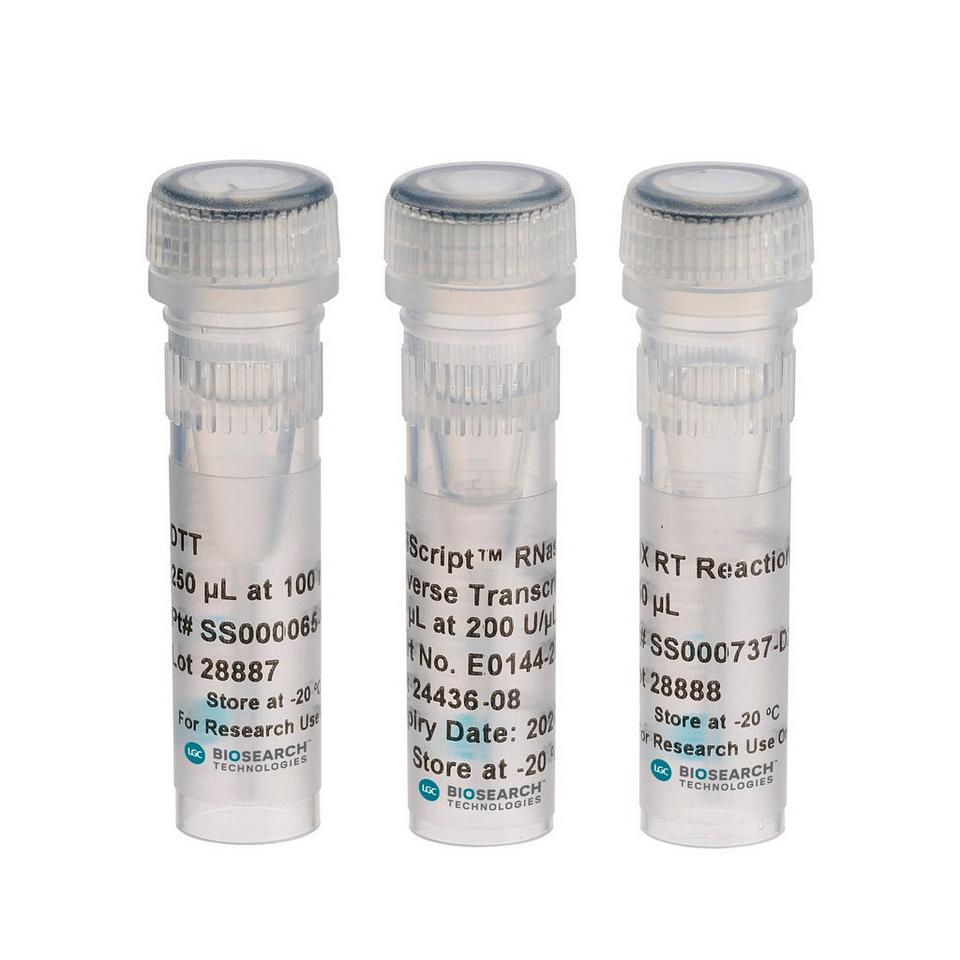EpiScript™ RNase H- Reverse Transcriptase
Applications
First-strand cDNA synthesis for subsequent PCR or real-time PCR.

EpiScript™ Rnase H- Reverse Transcriptase (EpiScript RT), an alternative to SuperScript® II Reverse Transcriptase, is a recombinant MMLV reverse transcriptase with greatly reduced RNase H activity. It is highly efficient at producing full-length cDNA from long RNA templates. EpiScript RT is capable of producing cDNA from as little as 50 pg of total RNA for real-time RT-PCR (qRT-PCR) analysis and other applications.The enzyme is available in 25,000 and 50,000 unit sizes at a concentration of 200 U/µl. The enzyme is supplied with a 10X Reaction buffer and 100 mM DTT.
Storage: Store only at -20°C in a freezer without a defrost cycle.
Storage Buffer: EpiScript RT is supplied in a 50% glycerol solution containing 50 mM Tris-HCl (pH 7.5), 100 mM sodium chloride, 1 mM DTT, 0.1 mM EDTA, and 0.1% Triton® X-100.
Unit Definition: One unit of EpiScript RT catalyzes the incorporation of 1 nmol of dTTP into acid-insoluble material in 10 minutes at 37°C using saturating amounts of oligo(dT)-primed poly(rA) as template.
Contaminating Activity Assays: EpiScript RT is free of detectable exonuclease, endonuclease, and RNase activities.

Figure 1. EpiScript™ Reverse Transcriptase performed equally or better than comparable reverse transcriptases from other vendors in 2nd strand-qPCR reactions. First- strand synthesis reactions were assembled according to manufacturer´s specifications. Input RNA was 1 µg of Jurkat total RNA (Ambion®). Reactions were primed using 50 ng of poly-T(16-18) DNA. 2nd strand qPCR was performed using Bio-Rad iQ SYBR mastermix and gene-specific primers that yielded 250-350 bp amplicons. Reactions were repeated 4-fold. PGDF-R (Platelet Derived Growth Factor Receptor), TNF (Tumor Necrosis Factor), IL-1b (Interleukin-1 beta), IL-2 (Interleukin 2). Image courtesy of Matthew Kellinger, Illumina® Inc.
 |
 |
Figure 2 (click to enlarge). EpiScript™ Reverse Transcriptase produces similiar transcript coverage independent of transcript length. EpiScript was used to prime first strand cDNA either from total RNA using oligo-dT (top panel) or polyA selected RNA with random hexamers (bottom panel). The cDNA was converted into Illumina®-compatible libraries and sequenced. The reads were aligned to transcripts based upon various length classes and read density plotted relative to the percent distance from the 5´ end of the transcripts; 0% refers to the 5´ end and 100 % is the 3´ end. As expected, oligo-dT priming results in a more pronounced 3´ bias than random priming. |
 |
Figure 3. Use of EpiScript® Reverse Transcriptase for first strand cDNA results in detection of similar transcript categories independent of input amount. EpiScript RT was used to random prime 5 ng or 50 pg of human total RNA and the cDNA was converted into libraries for Illumina® sequencing. Reads were aligned using Tophat and annotated with Cufflinks and the percentage of each major category is visualized as a pie chart. Equivalent results are observed for both 5 ng and 50 pg of input RNA. |
If you cannot find the answer to your problem then please contact us or telephone +44 (0)1954 210 200